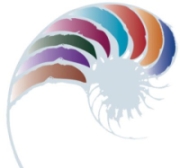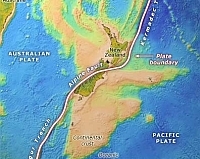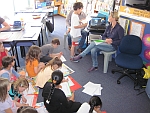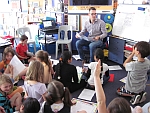
All LEARNZ field trips targeting primary and secondary schools are closely linked to the New Zealand curriculum, in particular health and physical education, science and social studies. They can also be used by other subject teachers.
Key concepts
Community involvement, disasters, earthquakes, emergencies, emergency management, extreme natural events, future focus, hazards, infrastructure, landslides, leadership, management, perspectives, planning for earthquakes, publicity, resilience, risk management, story telling, values, viewpoints.
The New Zealand Curriculum - NZC
Key Competencies
LEARNZ virtual field trips contribute to the development of all five key competencies:
| Key Competencies | Examples of Related Field Trip Components |
| Thinking | Constructing questions to put to experts during web conferences. |
| Using language, symbols and texts | Interpreting and making meaning of a variety of language and symbols in the Background Pages and throughout the web site. |
| Managing self | Numerous content-related Activities provide students with chances to engage with the material and create their own interpretation of the content. |
| Relating to others | Videos connect students with a range of expert opinions. Students listen actively when seeking answers to video questions. |
| Participating and contributing | LEARNZ Virtual Field Trips are an ideal medium for group-based topic inquiry. They also enable students to transfer new learning into the context of their own communities where they are encouraged to take action. |
(See page 12-13 NZC 2007)
Values
The Adapting After Emergencies field trip encourages, models and explores these values:
- innovation, inquiry and curiosity
- ecological sustainability
- community and participation
(see page 10 NZC 2007).
E-learning and pedagogy
The Adapting After Emergencies field trip directly involves learning that is supported by information and communication technology (ICT).
In particular, the trip will:
- Assist the making of connections by enabling students to enter and explore new learning environments, overcoming barriers of distance and time.
- Facilitate shared learning by enabling students to join or create communities of learners that extend well beyond the classroom.
- Enhance opportunities to learn by offering students virtual experiences and tools that save them time, allowing them to take their learning further (Page 36 NZC 2007).
Health and Physical Education
| Strand | Achievement Aims |
|
Personal health and physical development - A
|
A2 Regular physical activity L2: Experience creative, regular, and enjoyable physical activities and describe the benefits to well-being. L3: Maintain regular participation in enjoyable physical activities in a range of environments and describe how these assist in the promotion of well-being. L4: Demonstrate an increasing sense of responsibility for incorporating regular and enjoyable physical activity into their personal lifestyle to enhance well-being. L5: Experience a range of personally enjoyable physical activities and describe how varying levels of involvement affect well-being and lifestyle balance. A3 Safety management L2: Identify risk and use safe practices in a range of contexts. L3: Identify risks and their causes and describe safe practices to manage these. L4: Access and use information to make and action safe choices in a range of contexts. L5: Investigate and practise safety procedures and strategies to manage risk situations. A4 Personal identity L2: Identify personal qualities that contribute to a sense of self-worth. L3: Describe how their own feelings, beliefs, and actions, and those of other people, contribute to their personal sense of self-worth. L4: Describe how social messages and stereotypes, including those in the media, can affect feelings of self-worth. L5: Investigate and describe the ways in which individuals define their own identity and sense of self-worth and how this influences the ways in which they describe other people. |
|
Healthy communities and environments - D
|
D1 Societal attitudes and values L2: Explore how people’s attitudes, values, and actions contribute to healthy physical and social environments | Identify and use local community resources and explain how these contribute to a healthy community. L3: Identify how health care and physical activity practices are influenced by community and environmental factors. L4: Investigate and describe lifestyle factors and media influences that contribute to the well-being of people in New Zealand. L5: Investigate societal influences on the well-being of student communities. D2 Community resources L2: Identify and use local community resources and explain how these contribute to a healthy community. L3: Participate in communal events and describe how such events enhance the well-being of the community. L4: Investigate and/or access a range of community resources that support well-being and evaluate the contribution made by each to the well-being of community members. L5: Investigate community services that support and promote people’s well-being and take action to promote personal and group involvement. |
Social Science
| Strand | Achievement Aims |
|
Identity, Culture and Organisation Continuity and Change Place and Environment
|
Level 2: Understand how places influence people and people influence places. Level 3: Understand how people make decisions about access to and use of resources. Level 4: Understand that events have causes and effects. Level 5: Understand how people’s management of resources impacts on environmental and social sustainability. |
Science
| Strand | Achievement Aims |
|
Planet Earth and Beyond
|
Earth systems
Interacting Systems
|
English
The selected processes and strategies indicators used in the table below are from Level three of the NZC, but aim to cover indicators from levels two to four.
| Strand | Processes and Strategies Indicators | Example of Related Field Trip Component |
|
Speaking, Writing and Presenting
|
|
|
|
Listening, Reading and Viewing
|
|
|










